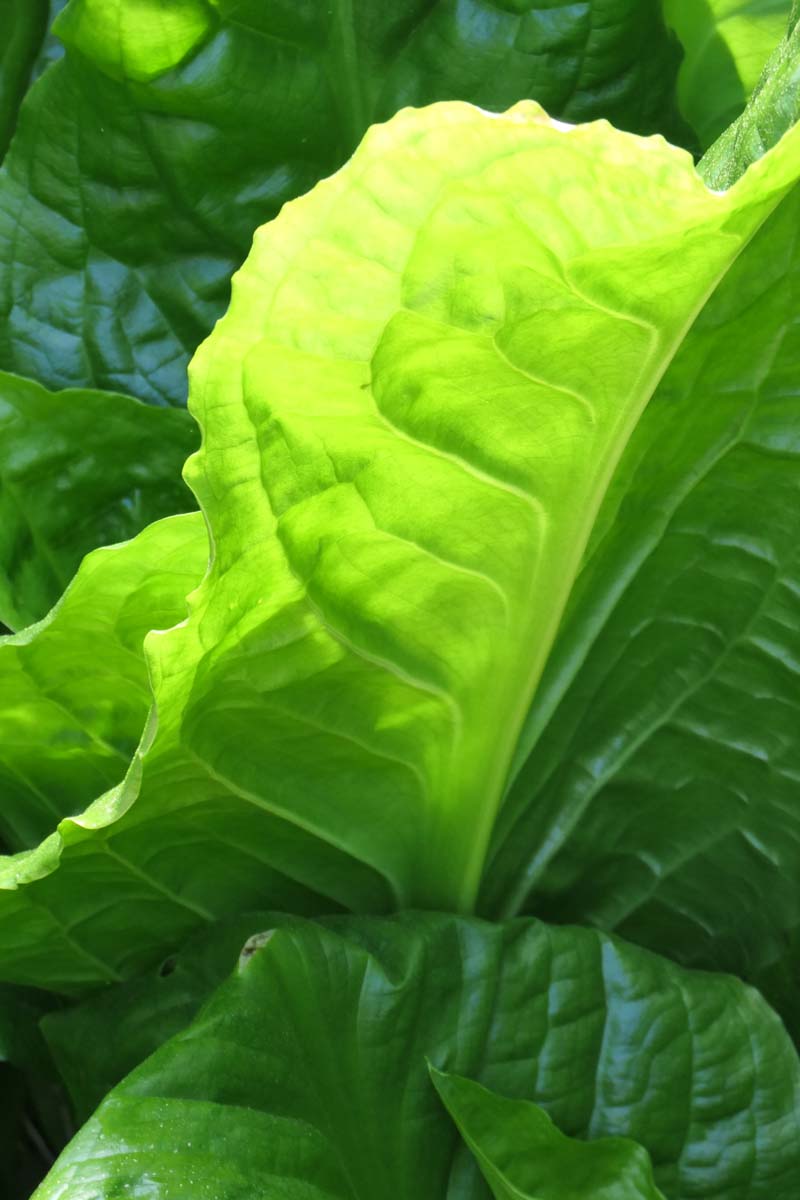You’ve probably walked by these plants during most of the year without noticing if you’ve hiked in Tryon Creek Park, or coastal areas or really anywhere in the Western United States where boggy hollows or streams can be found. Lysichiton americanus, commonly known as skunk cabbage, extends from Cook Inlet, Alaska, south through British Colombia and the Pacific Northwest states to Santa Cruz county, California, with isolated populations in Wyoming, Montana, and Idaho. It is part of the Arum plant family that also includes Calla lilies and Jack-in-the-Pulpit, found naturally in similar habitats.

Maybe the humongous size of the leaves caught your attention now and then – they grow to 3 feet long and 32 inches wide and are the largest of any native plant in the region. They grow from a rhizome that can reach over 12 inches long, and any individual plant can grow for some 20 years, with rhizomes believed to last for perhaps centuries, with seeds produced after the plant is 5 years old.

In February, however, you will be alerted to these plants by eyes and nose: they do smell faintly like a skunk and they have a crayon-yellow cape, called a spathe, surrounding their spadix, indeed looking like a little lantern, as suggested by nature writer Ruth Foster, from whom I learned much about today’s topic.



Turns out, they are botanical geniuses, if you will. They can produce heat, and the yellow spathe is shaped in a way that has the air inside circling around in a manner that maintains an even temperature, a warmth that attracts pollinating bugs and bees who come to warm up. Moreover that heat vaporizes the foul odor from all those tiny flowers on the fleshy center spike into the air, calling to insects with the false promise of dead animal for lunch (microbial decay rising the temperature of a carcass and it stinks!) On top of it all, different temperatures create different odors, in turn a magnet for different kinds of pollinators, giving these plants a large evolutionary advantage in early spring.

When I looked at them last week, the bloom was long over, with just a straggler or two providing a model. But the visuals were amazing none the less, with the waxy surface of the leaves reflecting light, and the interplay of back-lit appearance and shadows delighting the photographer.


It is important to remember that they are highly toxic, though, to humans and small mammals. Deer and bears seem to be able to tolerate the leaves, high in protein which they need after the winter season. But even a small taste for us would burn our mouth and cause laryngeal swelling that can lead to choking. The leaves and stems contain needle-like crystals of calcium oxalate that puncture mucous membranes like fire. (The name Arum for that plant family comes from the arabic word for fire – ar – appropriately.)




Early first-Nation people knew about this. They learned that roasting the roots of the plant, or cooking it with numerous changes of the boiling water, would make it safe as emergency food. The waxy leaves were used to wrap other cooked foods with no negative effects, or folded into cones for drinking cups. Boiled juice from the roots was also used as medicine for bad colds. The knowledge was included into the stories told from generation to generation.
“There’s an aboriginal legend about the origin of the flowering part of this plant. Long ago there were no Salmon. The People ate Skunk Cabbage leaves and roots. Finally, the Salmon came up the river and Skunk Cabbage, in human form, stood up and alerted the People to their arrival. In return, Skunk Cabbage was given an elk-skin blanket and a war club.”

From the Oregon encyclopedia:
On the lower Columbia and Willamette Rivers, the Kathlamet and Clackamas peoples had stories about skunk cabbage as an important food that kept people alive before the salmon first came to the rivers. In the Coosan Trickster cycle stories, the first Trickster learned how to cook skunk cabbage. He tried to eat it raw but spit it out. Then he put the root in hot ashes to cook. When it smelled sweet, he took it out. It tasted fine now, and so he said that is how human beings will cook it when they come into the world. Then he cut the root into many pieces and one at a time picked up a piece and put it down, each time saying, “Give this to your…” and naming a different kin name (mother, father, grandfather, and so on). In that way, he named familial relationships for the human beings to come in the world. (Ref.)
Note how multiple teachings are handed down in parallel: safety of food preparation as well as the learning of kinship structure, all wrapped in stories.





I tried to enjoy the beauty of the sight without giving in to pessimism: so much of global wetlands, marshes and bogs are of course endangered through climate change. If they are increasingly arid because of droughts, or if they are flooded by atmospheric river storms once too often, the conditions for skunk cabbage (as the rest of the indigenous flora) will be dire. Alas, I did not completely succeed in warding off catastrophic thinking. What else is new….

Clouds on the horizon, indeed. Here by Debussy, transcribed for 2 pianos…. Nuages.






Sara Lee Silberman
Interesting!
Jeanne Schapp
Wow Friderike — another winner! This is so interesting and especially the link to “Nuages”. What a fantastic way to start my morning. Also, I’m going to send this to my biologist sister and a couple of friends who will appreciate this too.
Thank you so much!
Maryellen Read
👍
Erik
Lovely chapter on a grand plant… Nuages perfect for evocations of moist vapors!